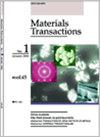硅钢局部非磁化改进中凝固缺陷的抑制
IF 1.9
4区 材料科学
Q4 MATERIALS SCIENCE, MULTIDISCIPLINARY
引用次数: 0
摘要
转子铁芯桥漏磁是内嵌式永磁电机所特有的问题。众所周知,桥的部分不磁化可以减少漏磁。在之前的研究中,提出了一种方法,即利用激光将Ni-Cr合金粉末与硅钢片熔化混合,使压接后的部分硅钢片非磁化,并将其层压制成转子铁芯。但由于最终凝固的零件存在裂纹、缩孔等凝固缺陷,因此提出了该工艺,使零件均匀,不存在凝固缺陷。因此,改进部分的面积增大。我们致力于开发一种新的非磁性合金来抑制凝固缺陷。将改进后的部分与不同含量的B进行激光熔化和混合,得到Fe -(15-20)质量%Ni -(15-20)质量%Cr -(2-3)质量%Si -(0-1.6)质量%B的成分。在无硼合金中观察到大的裂纹和大的缩孔。随着B含量的增加,裂纹和缩孔逐渐减少。通过抑制凝固缺陷,可以使非磁性改进面积最小化。从而降低了单件激光加工速度和昂贵镍的用量。这些新合金在部分非磁化过程中具有实际应用前景。本文章由计算机程序翻译,如有差异,请以英文原文为准。
Suppression of Solidification Defects in Partial Non-Magnetization Improvement for Silicon Steel
Leakage flux in rotor core bridges is a problem specific to interior permanent-magnet (IPM) motors. It is widely known that the partial non-magnetization of bridges reduces the magnetic flux leakage. In a previous study, a process was proposed whereby a part of the silicon steel sheet that bridges after pressing was non-magnetized by melting and mixing Ni–Cr alloy powder with a silicon steel sheet using a laser, and the rotor core was produced by laminating them. However, because the final solidification part had solidification defects, such as cracks and shrinkage cavity, the process was proposed to leave a homogenous part free of solidification defects. Therefore, the area of the improved portion increased. We focused on developing a new alloy for non-magnetic improvement to suppress solidification defects. The improved portion was melted and mixed using a laser with various B contents to obtain a composition of Fe–(15–20) mass%Ni–(15–20) mass%Cr–(2–3) mass%Si–(0–1.6) mass%B. Large cracks and large shrinkage cavity were observed in the boron-free alloy. The cracks and shrinkage cavity decreased with an increase in the B content. The minimization of the area of non-magnetic improvement is possible by suppressing solidification defects. Consequently, the laser processing speed per piece and the amount of expensive nickel were reduced. These new alloys show promise for practical applications in the partial non-magnetization process.
求助全文
通过发布文献求助,成功后即可免费获取论文全文。
去求助
来源期刊

Materials Transactions
工程技术-材料科学:综合
CiteScore
2.00
自引率
25.00%
发文量
205
审稿时长
2.7 months
期刊介绍:
Information not localized
 求助内容:
求助内容: 应助结果提醒方式:
应助结果提醒方式:


